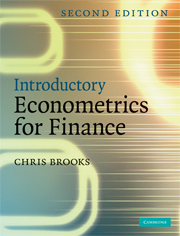Book contents
- Frontmatter
- Contents
- List of figures
- List of tables
- List of boxes
- List of screenshots
- Preface to the second edition
- Acknowledgements
- 1 Introduction
- 2 A brief overview of the classical linear regression model
- 3 Further development and analysis of the classical linear regression model
- 4 Classical linear regression model assumptions and diagnostic tests
- 5 Univariate time series modelling and forecasting
- 6 Multivariate models
- 7 Modelling long-run relationships in finance
- 8 Modelling volatility and correlation
- 9 Switching models
- 10 Panel data
- 11 Limited dependent variable models
- 12 Simulation methods
- 13 Conducting empirical research or doing a project or dissertation in finance
- 14 Recent and future developments in the modelling of financial time series
- Appendix 1 A review of some fundamental mathematical and statistical concepts
- Appendix 2 Tables of statistical distributions
- Appendix 3 Sources of data used in this book
- References
- Index
1 - Introduction
- Frontmatter
- Contents
- List of figures
- List of tables
- List of boxes
- List of screenshots
- Preface to the second edition
- Acknowledgements
- 1 Introduction
- 2 A brief overview of the classical linear regression model
- 3 Further development and analysis of the classical linear regression model
- 4 Classical linear regression model assumptions and diagnostic tests
- 5 Univariate time series modelling and forecasting
- 6 Multivariate models
- 7 Modelling long-run relationships in finance
- 8 Modelling volatility and correlation
- 9 Switching models
- 10 Panel data
- 11 Limited dependent variable models
- 12 Simulation methods
- 13 Conducting empirical research or doing a project or dissertation in finance
- 14 Recent and future developments in the modelling of financial time series
- Appendix 1 A review of some fundamental mathematical and statistical concepts
- Appendix 2 Tables of statistical distributions
- Appendix 3 Sources of data used in this book
- References
- Index
Summary
This chapter sets the scene for the book by discussing in broad terms the questions of what is econometrics, and what are the ‘stylised facts’ describing financial data that researchers in this area typically try to capture in their models. It also collects together a number of preliminary issues relating to the construction of econometric models in finance.
Learning Outcomes
In this chapter, you will learn how to
Distinguish between different types of data
Describe the steps involved in building an econometric model
Calculate asset price returns
Construct a workfile, import data and accomplish simple tasks in EViews
What is econometrics?
The literal meaning of the word econometrics is ‘measurement in economics’. The first four letters of the word suggest correctly that the origins of econometrics are rooted in economics. However, the main techniques employed for studying economic problems are of equal importance in financial applications. As the term is used in this book, financial econometrics will be defined as the application of statistical techniques to problems in finance. Financial econometrics can be useful for testing theories in finance, determining asset prices or returns, testing hypotheses concerning the relationships between variables, examining the effect on financial markets of changes in economic conditions, forecasting future values of financial variables and for financial decision-making. A list of possible examples of where econometrics may be useful is given in box 1.1.
- Type
- Chapter
- Information
- Introductory Econometrics for Finance , pp. 1 - 26Publisher: Cambridge University PressPrint publication year: 2008
- 2
- Cited by



